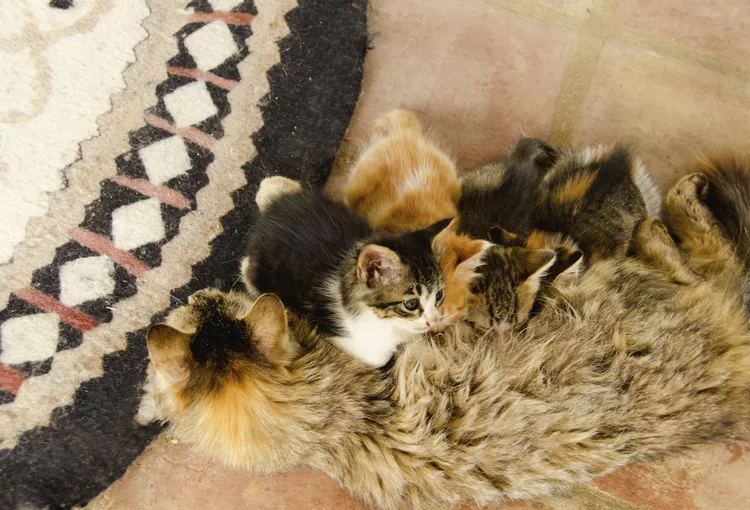How Soon Can a Cat Get Pregnant After Having Kittens?

Female cats can become pregnant again soon after having a litter of kittens. It can take only weeks, and some pregnancies can even begin while a cat is still nursing her kittens.
Most cats will have an estrus cycle (heat cycle) about four weeks after weaning their kittens if it's still the breeding season. Weaning the kittens typically takes about four weeks, so the heat cycle may arrive again around the eight-week mark. But, a cat can re-enter her heat cycle a week after giving birth, making it possible for her to become pregnant again.
When Can Cats Become Pregnant Again?
In North America, cats who aren't spayed typically enter their breeding seasons around February and peak around April, though mating can continue into the fall. And remember: Both male and female kittens tend to reach sexual maturity between 4 and 6 months of age.
Estrus is the period when female cats are receptive to mating; it's linked with the production of estradiol (a type of estrogen) produced by ovarian follicles. Female cats are induced ovulators, meaning ovulation doesn't occur without mating or manual stimulation. If the female cat does not mate while in heat, hormonal levels will eventually drop off, and the cycle will cease until it repeats itself in another two to three weeks.
Impregnated cats may mate several times before ovulation is complete and a female cat's litter may end up having kittens from multiple sires. On the street, a female cat in heat may mate with two or more male cats over the length of the estrus cycle, which spans seven to 21 days.
If she does mate, she can easily become pregnant during her first post-birth estrus cycle. However, repeat pregnancies with only short periods between giving birth can harm a cat's health. Bearing kittens, giving birth, and nursing them can exhaust a cat's physical resources, leaving her malnourished and exhausted.
Responsible breeders of purebred cats keep this in mind and limit the number of litters a given female cat will have, and keep a reasonable gap of time between litters to enable her to wean her kittens completely and to recover her optimum health. At some point, the female cat will be retired from breeding, at which time she will be spayed to prevent any further pregnancies and allow her to enjoy her senior years.
If your cat has had kittens and is not a quality breeding cat, it's best to have her spayed after the kittens are weaned. In the meantime, make sure she does not have access to intact male cats or the outdoors.
Reasons for Neutering and Spaying Cats
Unless you have a purebred cat, there is no legitimate reason to allow her to continue having kittens. There is still a significant pet overpopulation problem in the United States, so spaying and neutering pets is of the utmost importance.
Because kittens are so popular, the majority of people will end up adopting kittens instead of adult cats. This leaves the adult cats behind without homes and at risk of euthanasia. The more available kittens, the greater the risk of euthanasia for adult cats.
Once she's had kittens and weaned them, it's best to get a female adult cat spayed. All kittens should be neutered or spayed by the age of 4 months. Kittens can and will mate with their littermates when they become sexually mature, so it's best to make sure they are sterilized well before then. It can be very dangerous for young cats to become pregnant.
Spaying or neutering means your cats will be happier and will make better pets in the long run.